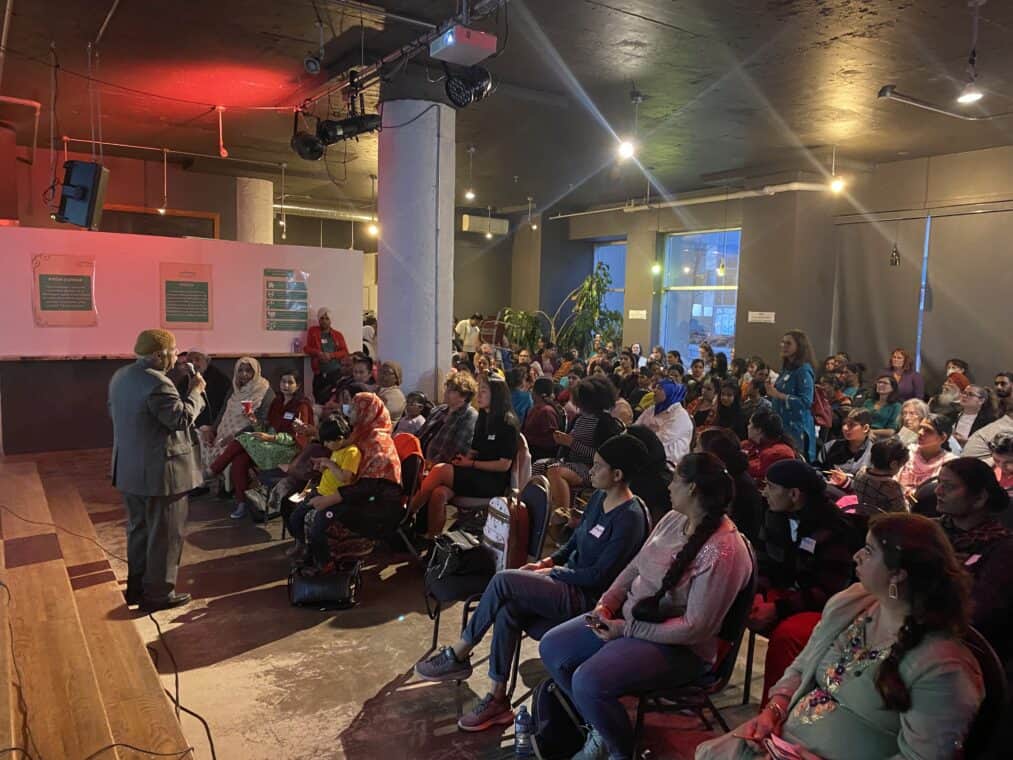Ten years ago, nine funders decided to try something new: they created a shared fund with the goal of deeper systemic change in Montreal neighbourhoods. The Collective Impact Project researchers share key lessons from the first phase and guidance for future endeavours.
More than a decade ago, Centraide of Greater Montreal and the Lucie and André Chagnon Foundation explored together how to enhance support for combating poverty and social exclusion in Montreal, where roughly one person out of five lived below the poverty line. Confronted with the fragmented and rigid nature of traditional funding mechanisms, representatives from neighbourhood round tables voiced a need for more flexible funding that would allow for collaborative work off the beaten path. Pooling their resources, the two organizations reached out to other foundations, laying the groundwork for the partnership that would become the Collective Impact Project (CIP).
In its initial phase (2015–2023), nine philanthropic players contributed $23 million to a shared fund dedicated to the development of collective initiatives across 17 neighbourhoods in Montreal. What drew these funders together was not only a quest for greater coherence and effectiveness in their funding strategies, but also a keen interest in the promising learning component of the CIP.
It was conceived as a departure from traditional philanthropic approaches, aiming to go beyond mere financial support and facilitate deeper systemic change. With the goal of catalyzing transformative change in public policies while integrating a community-driven perspective, the funders extended invitations to key strategic partners, including the City of Montreal, the regional public health department, and Montreal’s Neighbourhood Round Tables Coalition. Centraide of Greater Montreal assumed the operational leadership of the CIP, leveraging its existing strong ties with Montreal’s neighbourhood round tables, which served as the backbone support structures for the collective impact initiatives.

We have recently published an in-depth review (report is in French) of the first seven years of the CIP and are eager to share several key learnings here. As a multi-partner initiative on an unprecedented scale, it offers significant learning for the broader ecosystem. This comes at a critical juncture, where heightened collaboration among partners is imperative to address the social and environmental crises of our times.
The results we discuss stem from extensive research, including 23 individual and group interviews with community and philanthropic stakeholders involved in the project. Additionally, our analysis encompasses more than 100 activity, research, and evaluation reports generated throughout the project’s duration. These comprehensive data sources provide multiple insights into the project’s outcomes and offer essential guidance for future endeavours.
Flexible funding
One of the distinctive features of this initiative is its flexible funding, which grants neighbourhoods the autonomy to determine their focus areas and strategies, so long as they are developed and implemented collectively. This flexibility has spawned a diversity of initiatives, each unique in its approach and ambition, pursuing solutions tailored to specific contexts. The neighbourhoods’ initiatives address a variety of issues, with the most common ones being food access, inclusion, and housing. Some neighbourhoods have prioritized community infrastructure and spaces, or have focused on promoting educational and professional success through their initiatives.
One of the distinctive features of this initiative is its flexible funding, which grants neighbourhoods the autonomy to determine their focus areas and strategies.
In Saint-Michel, the CIP played a pivotal role in strengthening the local food system and contributed to establishing an urban agriculture program at the Louis-Joseph-Papineau high school. This initiative not only allows students to acquire valuable skills in horticulture and fosters educational success but also contributes to the local food system by supplying fresh produce to community groups and neighbourhood markets.
The neighbourhood of Ahuntsic proposed a School of Citizenship to explore new models of citizen engagement and empowerment, with both community workers and residents. Through their initiatives, residents have gained the skills and confidence to advocate for their rights and participate in decision-making processes that affect their lives. This grassroots approach to community development not only fosters a sense of belonging but also builds resilience and solidarity within neighbourhoods.
Others have experimented with new practices of collaboration or intervention; for example, through a network of outreach workers to fight isolation in Mercier-Est or through intersectoral collaboration and peer support to raise awareness and take action against unsanitary housing conditions in Côte-des-Neiges.
Additionally, some neighbourhoods have endeavoured to influence policies and regulations and shift mindsets. Although this entails risks and often yields uncertain and intangible outcomes, sustained efforts have resulted in increased awareness of poverty issues among elected officials and prompted policy changes at the local level. For instance, the West Island worked with the slogan “Making the invisible visible” and raised awareness among decision-makers and the public about food insecurity and housing issues in an area usually known for its affluence, leading to the establishment of a fund for affordable housing in Pierrefonds.
Strengthening collaborative practice
The support provided by the CIP extends beyond funding, to include training and coaching on various topics, in particular evaluation and collective impact. This has strengthened several collaborative practices, which is precisely at the core of the collective impact approach: we can succeed in transforming a situation by enhancing engagement and collaboration around a common goal and use strategic learning to adjust our actions.
Working toward collective change was a novel experience for nearly all the neighbourhoods involved in the CIP. One neighbourhood representative explains the cultural shift this implies: “For the groups, it’s also a big change in attitude to . . . say, ‘We’re working on a collective project, which means we have to talk . . . openly about our financing, our contributions.’ In every project, [we had to be] much more transparent about the investments we make, more proactive in our commitments. It changed something in our culture.”
The CIP significantly enhanced collaboration within the neighbourhoods, in terms of quantity, diversity, and depth of collaborations. Almost every initiative mobilized stakeholders from diverse sectors, transcending traditional boundaries and fostering innovative partnerships. Diverse community organizations, boroughs or municipalities, and community organizers from the local health agency were part of nearly all initiatives. In addition, the CIP also saw the involvement of schools, actors in community and social housing, and less typical partners, such as local businesses to better reach out to residents or other private actors, in initiatives related to housing and food.
We entered the CIP knowing we had the freedom to make mistakes, to try things out and see the outcomes . . . It is crucial to be able to take risks and adjust quickly.
CIP community partner
The flexibility and freedom within the CIP to experiment and make mistakes, coupled with a strong learning component integrated in every initiative, facilitated the adoption of new practices as this community partner shares in an interview: “We entered the CIP knowing we had the freedom to make mistakes, to try things out and see the outcomes. Embracing a systemic approach is essential for working on major issues, since we cannot have an impact on everything. It is crucial to be able to take risks and adjust quickly.” External factors, such as the pandemic, further spurred innovation, aided by the inherent adaptability of the community sector. A cross-sectional analysis revealed significant impacts of neighbourhood initiatives across multiple fronts. Beyond directly benefiting those affected by poverty and exclusion, initiatives have catalyzed changes in policies, practices, relations, and mindsets. Their contributions to all conditions of systems change are promising for more sustainable transformations.
Transforming philanthropy
The CIP enhanced collaboration not only in the participating neighbourhoods, but also among those sitting on its decision-making bodies. While Centraide had prior collaborative engagements with the city and public health through their support for neighbourhood round tables in Montreal, the CIP has brought new partners to the table and has deepened the collaborations. The CIP is sometimes referred to as a “school,” as it is seen as a transformative learning experience in community-development and collective work for philanthropic players with little or no prior experience in this field. It has helped transform practices within the ecosystem, reinforcing a bottom-up approach and greater power-sharing. As one of the stakeholders states: “The change happened gradually and led to a better understanding and recognition . . . For example . . . the recognition of the importance of having players whose main role is to make collaboration work, and . . . support collaborative approaches. These are all things we take for granted now, but that wasn’t the case when we started out.”
Centraide took up the roles of convener and fund administrator for partners in the CIP, roles that it subsequently adopts in other projects and which has led to simplified internal processes and more agile investment in response to community needs. More generally, the project fostered closer ties, mutual understanding, and collaboration, leading to partnerships extending beyond the project’s confines, such as the Initiative immobilière communautaire du Grand Montréal, supporting the acquisition of community-run buildings or office spaces, based on an idea sparked during a CIP meeting.
The initial desire of the funding partners to influence public policy and institutional practices at a regional level has proven more difficult to translate into concrete actions.
The initial desire of the funding partners to influence public policy and institutional practices at a regional level has proven more difficult to translate into concrete actions. Questions of legitimacy and the lack of clarity on who would lead such actions were among the main obstacles encountered, as they were not addressed directly. Despite limited progress in this area, partners have made significant advances in other systems-change conditions. By fostering closer collaboration, testing flexible funding, redefining their roles, and increasing power-sharing, they have laid the groundwork for broader transformations.
Integrate learnings for future development
The CIP’s adaptability and learning capacity is a key asset for the ongoing development of the project. Some of the limits stated already have been addressed to adjust the project. Early on, concerns about territorial equity arose, as neighbourhoods were selected to receive intensive, moderate, or no funding at all. For the second phase of the project (underway since 2022), the partners decided to reserve a budget for all neighbourhoods with a neighbourhood round table and to adjust the investments according to their socio-demographic characteristics. Initial critiques of insufficient representation of community actors in decision-making led to the integration of community representatives in every single governance body in CIP’s phase two.
Finally, while the achievements within every neighbourhood initiative as well as the outcomes of collaboration in governance bodies were impressive, there seemed to be little collaboration between neighbourhoods on the one hand, and almost no contact between neighbourhood initiatives and philanthropic and institutional partners on the other. This left us with a feeling of untapped potential for wider collaboration.
To bring the project to another level, relationship-building and increased mutual knowledge between philanthropic and institutional players and those involved in neighbourhood initiatives needs to be reinforced.
To bring the project to another level, relationship-building and increased mutual knowledge between philanthropic and institutional players and those involved in neighbourhood initiatives needs to be reinforced and has become the main focus since the launch of phase two. This can be achieved only through a strong engagement of community actors, which requires first and foremost strengthening and stabilizing resources within the community sector through increased flexible and multi-year funding and ensuring the sustainability of impactful initiatives.
Stakeholders are committed to addressing these challenges and building on lessons learned to drive lasting change across Montreal neighbourhoods. The CIP’s journey illustrates the transformative potential of collaboration among diverse stakeholders, strengthened by continuous learning, mutual understanding, and a commitment to continually adapt.


